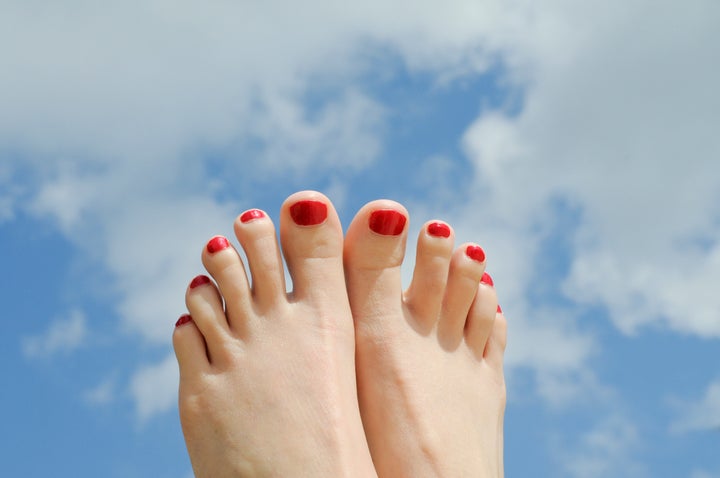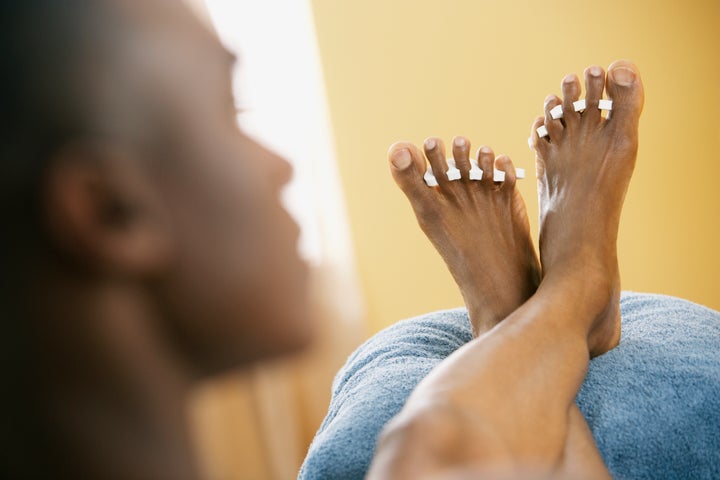
We all started out with lovely feet. Just play This Little Piggie with a baby and you’ll see what used to be yours, before city pavements, uncomfortable shoes and pounding exercise contributed to years of wear and tear.
While many of us want to feel good about what we’re showing off in sandals, it can be a leap of faith to remove our shoes and socks in the presence of a professional, whether it’s a pedicurist or a podiatrist.
Are they checking out our feet and judging? And what, if anything, can they tell about us from looking at our feet?
“There are so many people who apologise for the condition of their feet when calling for an appointment,” says manicurist Erin Beckett-Gland. “They’re embarrassed and warn me that they look awful. But that’s why I’m here – to help them find the healthy feet they can feel confident in showing during sandal season.”
Even if your feet truly look bad, keep in mind that professionals have seen pretty much everything.
“Truth be told, there are a lot of gnarly things that can happen to your feet, and you should not feel embarrassed about them one bit,” says podiatrist Brad Schaeffer, a cast member of the TLC show My Feet Are Killing Me. “Everyone has wild foot issues, and most of them are easily treated with proper care.”
What your feet say about you
“Feet often tell a story,” Beckett-Gland said. “I can tell when someone is wearing shoes too small for them by the way their toenails split or their toes are curled into hammer toes or claw toes. I can tell when they over pronate, roll their feet inward too much or need an arch support because they have the signs of a bunion and the big toe deviating.”
Podiatrist Robert Spalding, author of “The Science of Pedicures,” said that “hyper-thickened calluses are a dead giveaway of abnormal pressure points on the foot or toes.”
One of the first things he does is check out the shoes someone wore to the appointment. “I match the foot to the shoe, since shoes can aggravate or improve almost 90% of most foot and toe problems,” Spalding says.
You might even be giving away some clues to your profession during an appointment. “We podiatrists have a big patient base among those whose jobs require a lot of standing, like warehouse employees, letter carriers and restaurant employees,” Spalding says. “I’ll notice the shape of their foot, since the more that pressure is applied to the foot, the more it will splay, which means it gets wide and long over time.”
Professionals might also get a hint about some of your activities based on your feet. “When someone comes in with fungal issues, I might ask questions to see if they picked those up from walking around their gym barefoot, or from frequenting poor-quality nail salons,” Schaeffer says.
It’s easiest to spot runners and climbers because of the damage to their big toenails, says nail artist Vanessa Sanchez McCullough. “Constantly banging the big toe against the sneaker usually creates nail damage that will appear bruised, and many times causes the nail to lift from the nail bed.”
Other types of shoes leave their mark, too. “People who wear high heels a lot will very often have bunions and excessive calluses around the toes,” she says.

They can even flag health issues that may require a doctor
“A well-educated pedicurist can spot potential health issues, because both fingernails and toenails can be windows to a person’s health,” McCullough says.
Beckett-Gland says she refers customers to a healthcare professional if she notices a serious abnormality or other cause for concern.
Sometimes, concerns about a foot problem can lead to a serious diagnosis, Schaeffer says. “We look at the skin, pulses and nerves to determine any underlying conditions,” he says. “Diabetes is probably the most common diagnosis that we can assess during a foot exam. Other times, melanoma can be found in the feet.”
The mistake most people make before an appointment
For your safety, you shouldn’t use shave your legs for the day or two before a pedicure. “A razor nick can be a perfect portal for infection,” Spalding says.
There’s also no need to prep your toenails before a pedicure. “So many times, people get impatient and cut their toenails before their appointment,” McCullough says. “They come see me with really short nails that are difficult to make look pretty.”
Instead, follow Beckett-Gland’s advice to keep it clean and simple: “I wish people would just take a shower before they come in for an appointment. I want them to come with clean, dry feet, with no added lotion, creams or oils. I need to see the feet in their natural state so I can actually see what the issues are.”
How to take care of your feet between appointments
There are steps you can take at home to keep your feet looking and feeling good. “Exfoliate the sole of the foot once a week with a foot file or a good scrub,” Beckett-Gland said. “Pumice stones are too porous, harbour too much bacteria and are not beneficial to the exfoliation process.”
But don’t stop there. “You must moisturise your feet after exfoliation,” McCullough says. “If you don’t, you’ll find your feet will be drier than before you started.”
Choose a rich lotion intended for feet, experts says. “The basic body lotion isn’t going to cut it when it comes to the soles of the feet,” Beckett-Gland says. “The sole of the foot has no hair follicles, so there are no sebaceous glands to help protect the skin from drying out. Soles also have an extra layer of skin that is nowhere else on the body. Choose products that have a molecular structure small enough to penetrate the sole of the foot skin.”
When in doubt, go to the professionals.
“The best way to maintain a great pedicure is to get pedicures often,” McCullough says. “Most of my clients get bi-weekly pedicures along with their manicures, and they have beautiful feet. Bi-weekly may be too much commitment for some people, so every four weeks is sometimes more realistic.”